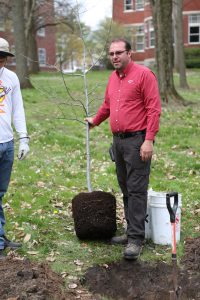
Tim Riley — On a warm spring day in 2016 during Earth Week, Tim Riley hosted an arboretum walk with a small group of interested faculty and students. The agenda was to discuss the past, present and the future of Indiana’s trees and the part Wabash College Arboretum plays in that future.
An early activity on the tour had the group holding a rope in a circle fifty seven feet in circumference, roughly eighteen feet in diameter which is the size of most above ground pools. This represented the trunk size of the largest tree ever recorded in Indiana, an American Sycamore (Plantanus occidentalis), located near Kokomo. However, at the time of this discovery, the grand old tree had fallen to the ravages of nature and a gnarled and ancient stump greeted the lands new inhabitants and explorers. It is considered the world’s largest Sycamore stump measuring twelve feet high and eighteen feet in diameter. In 1916, the stump was relocated to the Kokomo City Park for preservation. It is still there today along with other attractions like the world’s largest steer exhibit, if that is your type of thing. Trees are the silent sentinels who endure generations and are at the very heart of what gives Wabash College and the state of Indiana some of the most beautiful landscapes in the country.

Wabash College Arboretum has a diverse and near complete collection of Indiana native tree species. There are a few that are not represented on campus but most are unable to grow in our climate and do not reflect the state’s general population of trees. We also have many other species that are not native to Indiana but still very valuable assets to the campus. The Arboretum consists of close to ten acres of slightly rolling terrain, covered with shade and proud strong trees bordering the East and Northeast side of campus. Oak, Maple, Beech, Tulip and Ash are the most abundant species of trees. The book, “50 trees of Indiana” written by T.E. Shaw, has been the long time standard for the planting of the Wabash Arboretum. Of the 50 trees selected by Shaw, we have over 80% represented on campus. We are always striving to have representatives of every tree species that is native to our state and plant around twenty new trees each year.
The future of Wabash’s arboretum is exciting and worrisome. Since 2010 there has been several years of weather extremes. Not always damaging storms take out our gentle giants, but excessive periods of heat, drought, and rainfall have brought an end to many of our most historic trees. These environmental extremes add stress that has led to secondary pressures of pest and disease. Many of the older trees are suffering or have succumbed to these secondary pressures. The Emerald Ash Bore is now widespread in Montgomery County. Preventive treatments are ongoing, with hopes to save a small population for future study. Unfortunately, Ash trees ( Fraxinus) will be the next great tree species to be all but eliminated in our State and on our campus. But cases like that of the Ash tree spur on new hybrids and species tolerant to its predecessors killers. Trees like the American Chestnut and American Elm once were plentiful but now are few in number throughout the state. But we now have new hybrid species being introduced with a strong resistance to the pests and disease that once took them out. Each year brings a new set of challenges, but we are committed to preserving our campus trees and doing all we can to ensure Wabash will Always be a place where trees Flourish and shade the next generations of Wabash Men.